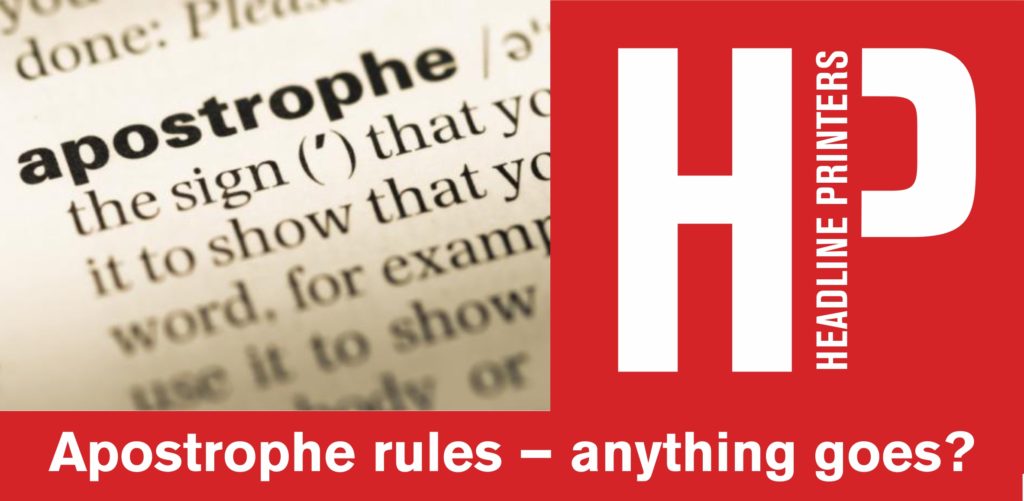Apostrophe rules – anything goes?
The misuse of apostrophes is one of the most common grammar mistakes marketers can make. And there has been no shortage of brands being called out because of it.
Waterstones use to be called Waterstone’s until they dropped the apostrophe in 2012 for online use. While Starbucks have never used an apostrophe in their branding whatsoever.
So, is it high time all brands drop the apostrophe?
We take a look at the correct use of an apostrophe, why they’re used, and whether or not they still matter in a digital sphere.
When to use an apostrophe
Apostrophes are a type of punctuation, typically used towards the end of a word. They usually show:
- Where letters have been left out
- Possession of an object
- Controversially, plural forms of certain words, numbers or symbols
Apostrophes should always appear as part of a word, and never on their own.
What are the three uses of an apostrophe?
An apostrophe has three uses, or placements, in a word.
Contractions
Contractions are used to combine two short words into one, such as ‘it is’ becoming ‘it’s’, or ‘they would’ as ‘they’d’. You usually knock one or two letters off the front of the second word, then combine the two words with an apostrophe – for instance, ‘we will ‘to ‘we’ll’. However, in some cases, the apostrophe can appear within the second word, such as ‘has not’ becoming ‘hasn’t’.
Possessive nouns
If you’re showing that someone owns something, you should use both an apostrophe and an ‘s’ at the end of a word, such as ‘the brand’s brochure’.
However, when it’s a plural possessive, the apostrophe can come after ‘s’. For example, using, ‘the designers’ project’, to indicate that there are multiple designers involved.
An apostrophe can also come after of a word that ends in ‘s’ to denote a possessive. For example ‘Iris’ pen’ is the pen that belongs to Iris. That said, it’s also become acceptable to write ‘Iris’s pen’, which is actually closer to natural spoken language in modern times.
There are many acceptations to this rule, hence why this is the one brands often get wrong.
Plurals
In most cases, you don’t need an apostrophe to mark the plural form of a word. However, you still see many instances of this usage, which is known as the ‘Grocer’s Apostrophe’.
Next time you’re shopping, look out for signs such as ‘easy-peel orange’s’ or ‘bag of carrot’s’.
While rules are there to be broken, this usage isn’t recommended as it’s widely regarded as just plain wrong and might reflect poorly on your professionalism as a brand. However, there are occasions when apostrophes are becoming accepted in plurals, as we’ll come to see…
Exceptions to the rules
There’s one notable occasion when we DON’T us the possessive apostrophe denoting ownership and that is in the case of pronouns such as our, your, their, and it. When they possess something, that thing becomes ours, yours, theirs or its, without the customary apostrophe.
So we wouldn’t use an apostrophe in the sentence:
The dog wags its tail.
But we would still use the apostrophe for contracting ‘it is’ to become ‘it’s’, as in:
The dog wags its tail when it’s excited.
There are also occasions when an apostrophe can be used for a plural. This is generally where the insertion of an apostrophe will make your meaning clearer, such as referring to single letters or numbers.
For example, it’s difficult to ascertain the meaning of this sentence:
The word Mississippi has four is.
Whereas an apostrophe clarifies the situation:
The word Mississippi has four i’s.
Another example of an apostrophe helping out with plurals is in the phrase:
Do’s and Don’t’s.
Which would be confusing were we just to write:
Dos and Don’ts.
Sometimes you’ll see the last apostrophe omitted like this:
Do’s and Don’ts.
While this is inconsistent, it’s less messy looking which, is why it’s widely used and understood.
Numbers and years often use a plural apostrophe too, as in:
Babies born in the 2020’s
The apostrophe here isn’t strictly speaking correct, or even necessary, but it’s a growing convention that’s widely accepted, so it’s unlikely to attract complaints from anyone but the strictest grammarian.
These plural uses for the apostrophe are largely a matter of taste. It’s up to you how you use them, but once you’ve made a call, try to remain consistent — especially in brand communications.
Why do we use apostrophes?
We use apostrophes to improve readability and show the function of a word. Contractions are frequently used in digital, to make the text more easily scannable to the reader.
But without an apostrophe, the meaning of the word is easily lost.
For example, if we’ll (we will) lost the apostrophe, it’s suddenly read as well – which already has several meanings, from health to water. Instead, the apostrophe tells the reader to see the contraction as two entities.
The placement of the apostrophe for possessives also helps the reader determine whether one or more individuals are doing the possessing.
Going back to the ‘Grocer’s Apostrophe’ example, some critics argue it should be ‘Grocers’ Apostrophe’. Which one is right? Well, it depends on whether we understand there to be just a single grocer or a collective of grocers. If there’s just one it’s ‘Grocer’s Apostrophe’, if there’s more than one it’s ‘Grocers’ Apostrophe’
Apostrophe examples
In most cases, misusing an apostrophe is a common mistake, which won’t draw too much negative attention to your brand. But sometimes, getting an apostrophe wrong can actually change the meaning of a word into something totally different.
For example, a supermarket sign listing out what you’ll find on this particular aisle:
Pet’s
Cleaning
Toiletries
The aisle actually contains three separate categories of product. The misuse of the apostrophe here seems to invite us to read it as a short sentence though. In one interpretation, the apostrophe turns “Pet’s” into a possessive noun, implying that the cleaning and toiletries belong to a pet, Alternatively, it could turn “Pet’s” into a contraction of “Pet is” – suggesting that there’s a pet who’s cleaning up some toiletries. Either way, it certainly not what the supermarket intends to tell us with this sign!
Marketing slogans
Of course, there are some brands you’d expect to see the correct use of apostrophes over others, especially when it’s literally in their name. Back in 2014, café chain Apostrophe was nominated for the bad grammar award for their marketing slogan:
Great taste on it’s way
If your brand is named after a type of grammar, it’s probably best to triple check your marketing campaigns before they go live. But apostrophes are just one of many pitfalls when it comes to slogan writing. For more advice, check out our six tips for writing advertising slogans.
Outdoor signs
Brands that specialise in lettering should also take note, especially when undertaking conspicuous outdoor advertising. For instance, the company in America who offered:
Professional Sign’s & Lettering
Or a tattoo parlour advertising:
Tattoo’s and Body Piercing
After all, if someone is creating a sign for you, or inscribing permanent lettering on your skin in the form of a tattoo, you want to know that they know the rules!
Do apostrophes still matter?
Back in 2019, the Apostrophe Protection Society disbanded, having failed to stop the widespread misuse of apostrophes. According to the founder, “modern times have won”, but many still argue over the importance of an apostrophe.
Apostrophes may not be top of the priority list for marketers, but they still deserve some thought. After all, if it comes down to choosing between your brand, and a competitor who has misused an apostrophe, you might just gain a winning edge for correct grammar alone.
Now you know when to use an apostrophe, and when you really shouldn’t, you can create your next marketing materials with confidence.






